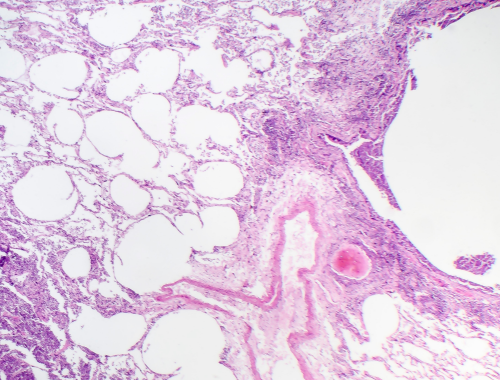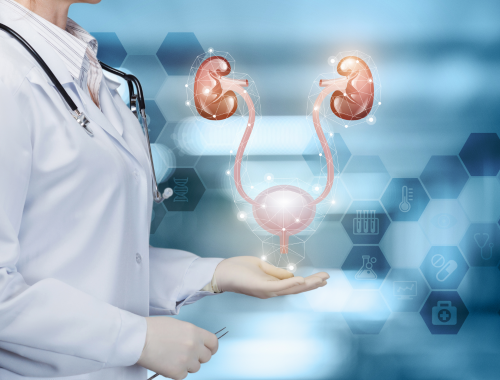Difference Between Interstitial Cystitis and Overactive Bladder
Interstitial cystitis and overactive bladder are two conditions that involve the urinary bladder. Interstitial cystitis is a debilitating medical condition that is characterized by pelvic pain and dysuria. Overactive bladder is a syndrome that is characterized by urinary urgency, frequency, and nocturia.

What is interstitial cystitis?
Definition:
Interstitial cystitis is a debilitating medical condition that is characterized by pelvic pain, bladder pressure, and dysuria, without an ongoing bacterial infection or obvious pathology.
Cause:
The exact cause of interstitial cystitis is unknown however it is believed that the condition occurs due to defective bladder epithelium.
Symptoms:
The symptoms of interstitial cystitis include pelvic pain in women, perineal pain in men, urgency, nocturia, frequent passing of small amounts of urine, bladder discomfort after filling, and painful sexual intercourse.
Risk factors:
The risk factors for interstitial cystitis include female gender, age of 30 or above, and history of chronic pain disorders like irritable bowel syndrome, vulvodynia, and fibromyalgia.
Diagnosis:
Initial diagnostic tests for interstitial cystitis include a thorough medical history, pelvic exam, urine dipstick and culture, and urine cytology. Cystoscopy and biopsy are particularly important in confirming the condition.
Treatment:
Treatment options for interstitial cystitis include pelvic floor exercises, non-steroidal anti-inflammatory drugs like ibuprofen and naproxen, tricyclic antidepressants like amitriptyline, antihistamines, transcutaneous electrical nerve stimulation, and surgical options like bladder resection and augmentation.

What is an overactive bladder?
Definition:
Overactive bladder is a syndrome that is characterized by urinary urgency, frequency, and nocturia. The urinary urge is very difficult to control in an overactive bladder.
Causes:
Involuntary contractions of the detrusor muscle cause an overactive bladder. These are seen in several conditions. Pelvic trauma or pregnancy can stretch the bladder wall and weaken it. A few diseases cause nerve damage which results in weak bladder nerve supply. These include disc herniation, multiple sclerosis, stroke, metastatic cancer, and Parkinson’s disease.
Symptoms:
Symptoms of overactive bladder include urge incontinence, dribbling of urine, frequent urination, and nocturia.
Risk factors:
The risk factors for an overactive bladder include increased age, history of diabetes, prostate hyperplasia, stroke, or Alzheimer’s disease.
Diagnosis:
Diagnosis of overactive bladder is established through history, physical examination, urine analysis, bladder function test, and neurologic assessment.
Treatment:
Treatment options for overactive bladder include pelvic floor exercises, bladder training, intermittent catheterization, antimuscarinic drugs, and surgical augmentation of the bladder.
Difference Between Interstitial Cystitis and Overactive Bladder
Definition:
Interstitial cystitis is a debilitating medical condition that is characterized by pelvic pain, bladder pressure, and dysuria, without an ongoing bacterial infection or obvious pathology. Overactive bladder is a syndrome that is characterized by urinary urgency, frequency, and nocturia. The urinary urge is very difficult to control in an overactive bladder.
Cause:
The exact cause of interstitial cystitis is unknown however it is believed that the condition occurs due to defective bladder epithelium. Involuntary contractions of the detrusor muscle cause an overactive bladder. These are seen in several conditions. Pelvic trauma or pregnancy can stretch the bladder wall and weaken it. A few diseases cause nerve damage which results in weak bladder nerve supply. These include disc herniation, multiple sclerosis, stroke, metastatic cancer, and Parkinson’s disease.
Symptoms:
The symptoms of interstitial cystitis include pelvic pain in women, perineal pain in men, urgency, nocturia, frequent passing of small amounts of urine, bladder discomfort after filling, and painful sexual intercourse. Symptoms of overactive bladder include urge incontinence, dribbling of urine, frequent urination, and nocturia.
Risk factors:
The risk factors for interstitial cystitis include female gender, age of 30 or above, and history of chronic pain disorders like irritable bowel syndrome, vulvodynia, and fibromyalgia. The risk factors for an overactive bladder include increased age, history of diabetes, prostate hyperplasia, stroke, or Alzheimer’s disease.
Diagnosis:
Initial diagnostic tests for interstitial cystitis include a thorough medical history, pelvic exam, urine dipstick and culture, and urine cytology. Cystoscopy and biopsy are particularly important in confirming the condition. Diagnosis of overactive bladder is established through history, physical examination, urine analysis, bladder function test, and neurologic assessment.
Treatment:
Treatment options for interstitial cystitis include pelvic floor exercises, non-steroidal anti-inflammatory drugs like ibuprofen and naproxen, tricyclic antidepressants like amitriptyline, antihistamines, transcutaneous electrical nerve stimulation, and surgical options like bladder resection and augmentation. Treatment options for overactive bladder include pelvic floor exercises, bladder training, intermittent catheterization, antimuscarinic drugs, and surgical augmentation of the bladder.
Table of differences between interstitial cystitis and overactive bladder

FAQs
Is overactive bladder and IC the same?
No, they are two different conditions.
How do you rule out interstitial cystitis?
Diagnostic tests for interstitial cystitis include a thorough medical history, pelvic exam, urine dipstick and culture, and urine cytology. Cystoscopy and biopsy are particularly important in confirming the condition.
What can mimic interstitial cystitis?
Urinary tract infection, bladder tumors, endometriosis, prostatitis, and sexually transmitted infections mimic interstitial cystitis.
How do I know if my bladder is overactive?
Overactive bladder is characterized by the inability to hold your pee after an urge to urinate.
How many times a day do you pee with interstitial cystitis?
As much as 40-60 times in severe cases.
How do urologists treat interstitial cystitis?
Treatment options for interstitial cystitis include pelvic floor exercises, non-steroidal anti-inflammatory drugs, tricyclic antidepressants, antihistamines, transcutaneous electrical nerve stimulation, and surgical options like bladder resection and augmentation.
- Differences Between Reptiles and Amphibians - May 17, 2024
- Difference Between Ophthalmology and Optometry - May 15, 2024
- Difference Between Fear and Anxiety - April 2, 2024
Search DifferenceBetween.net :
Leave a Response
References :
[0]Andersson, Karl-Erik. "Antimuscarinics for treatment of overactive bladder." The Lancet Neurology 3.1 (2004): 46-53.
[1]Wein, Alan J., and Eric S. Rovner. "Definition and epidemiology of overactive bladder." Urology 60.5 (2002): 7-12.
[2]Messing, Edward M., and Thomas A. Stamey. "Interstitial cystitis early diagnosis, pathology, and treatment." Urology 12.4 (1978): 381-392.
